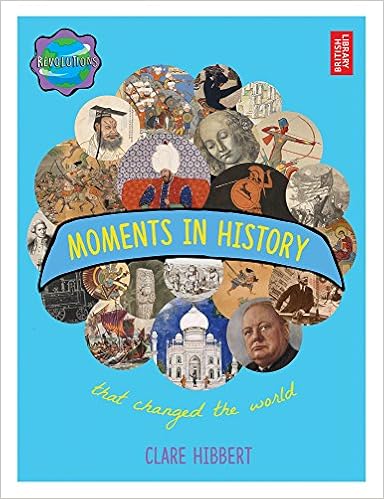
One of the problems with presenting humankind's history as a timeline is that not a lot happened at perfectly identified times. Of course we can pinpoint when the US Declaration of Independence was signed, or when Poland was invaded in September 1939, but when (and even why) the Maya cities died out? We don't know. How do you pin a date to the Renaissance, or the invention of the modern city? This book may aim to be a portrayal of key moments in time, but even it admits you have to be vague in itemising the specific days and dates. Get over that, and the pages are packed with information.
Yes, this is definitely aimed for the school shelf, and for an audience who probably haven't lived through any such definitive moments in history, arriving as they did too late for 9/11. In self-contained double page spreads we travel from the first picture writing and cave decorations up to World War 2. Mansa Musa, and the Mughals, are topics that were new to me, even considering the various similar books I've seen in my time, which means that probably most people can pick up something new here, even if they find themselves, like me, too fuddy-duddy for the presentation.
It's a very bitty book. In splitting the narrative of our history into four chunks the design doesn't really differentiate the chapter heading spreads, and the main pages themselves don't always allow a proper reading line. You have to take this titbit here, that factoid there, that box-out there (which introduces something actually shown above it) and get the overall picture. That's fine if you're grabbing a headline for a school project, but a full essay won't come from this.
What may well come from it is a full appreciation of how pictorial our past has been. So many ancient prints are reproduced here – we don't get the full caption detailing what they are, but we learn why they're significant to the topic at hand. Portraits and maps join in with so many other illustrations and leave you always keen to peruse the page and get the visual detail, however haphazard the script. There are lessons to be had from the nature of the imagery alone – it's galling that the first photograph presented here is of a WWI tank.
So yes, the pattern of the page can eventually be discerned, but I found myself admiring the archive visuals here more than the written data. That is all relevant, salient and accurate, but the changes of history don't always happen in singular events, and reveal themselves in an accumulation of different details. Luckily the order of those details here builds into a flow, even if the short bits of information as they're presented belie that fact. I can see the right pupil learning more than just a few beats of time from these pages.
No comments:
Post a Comment